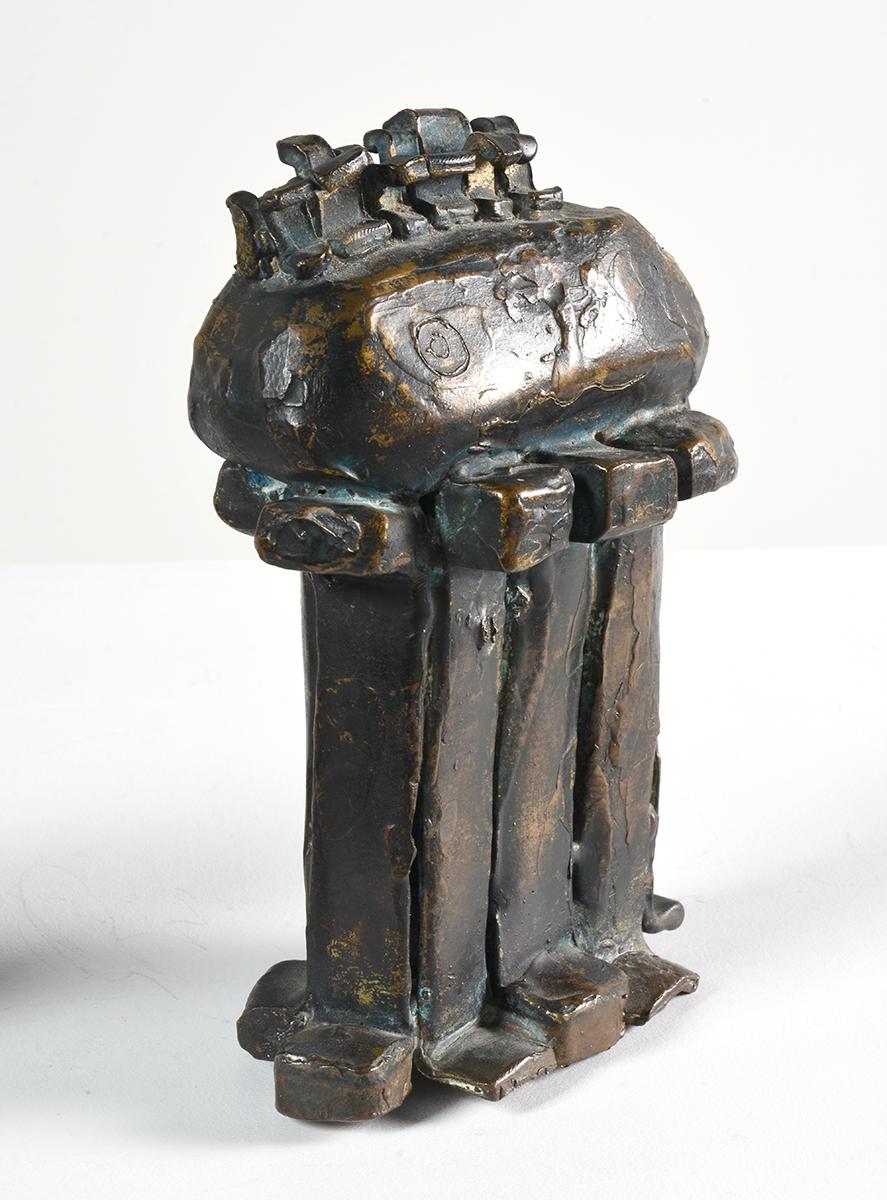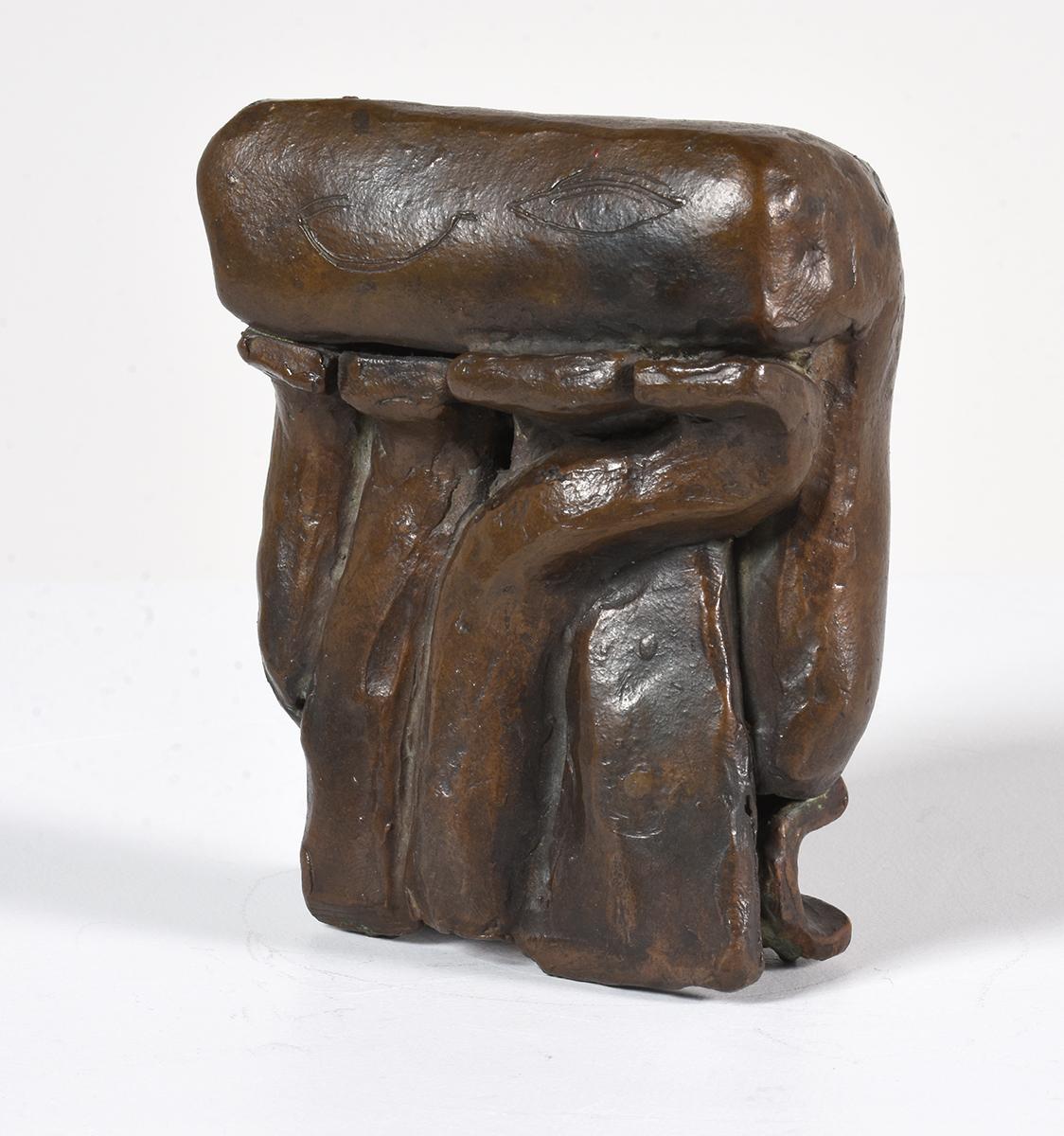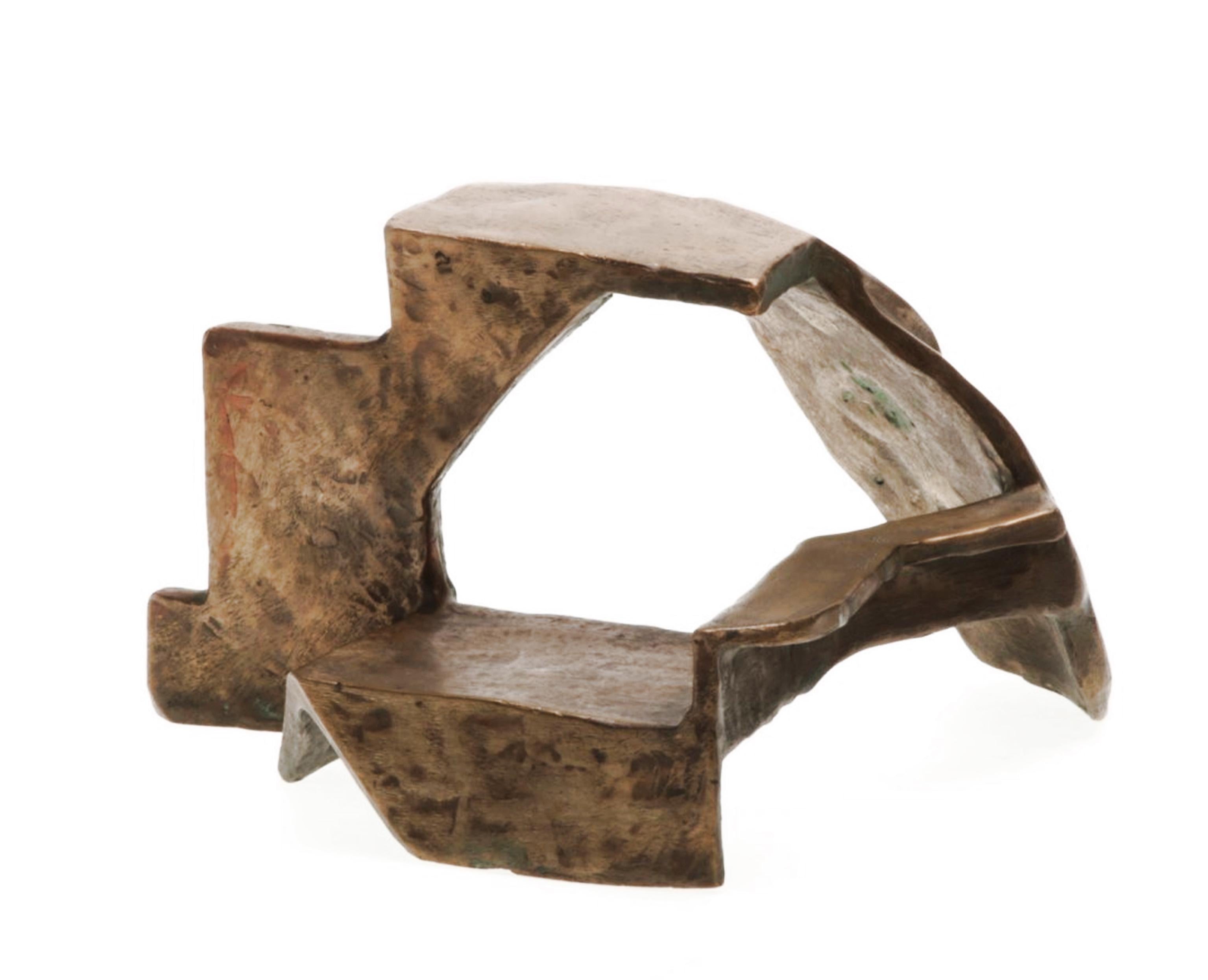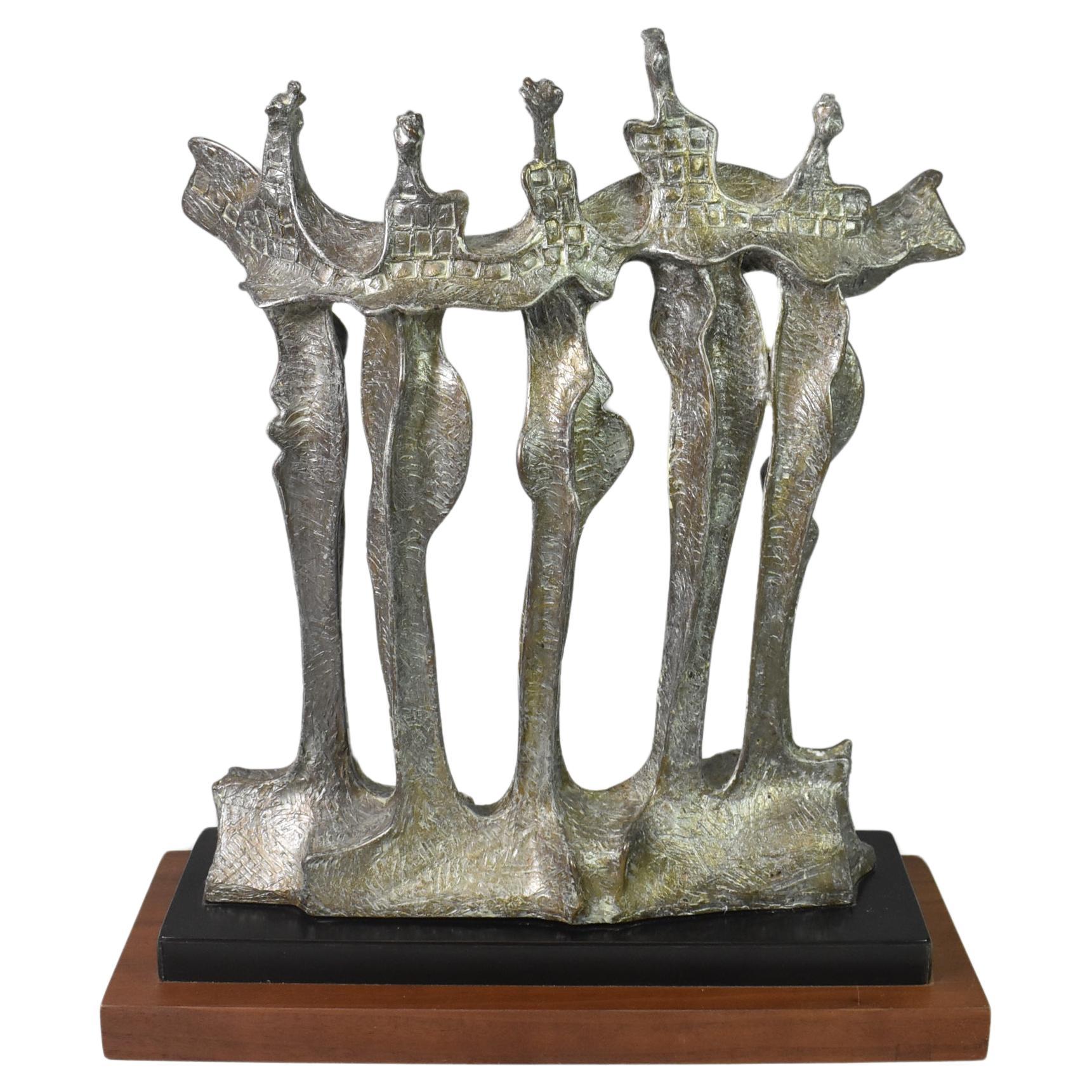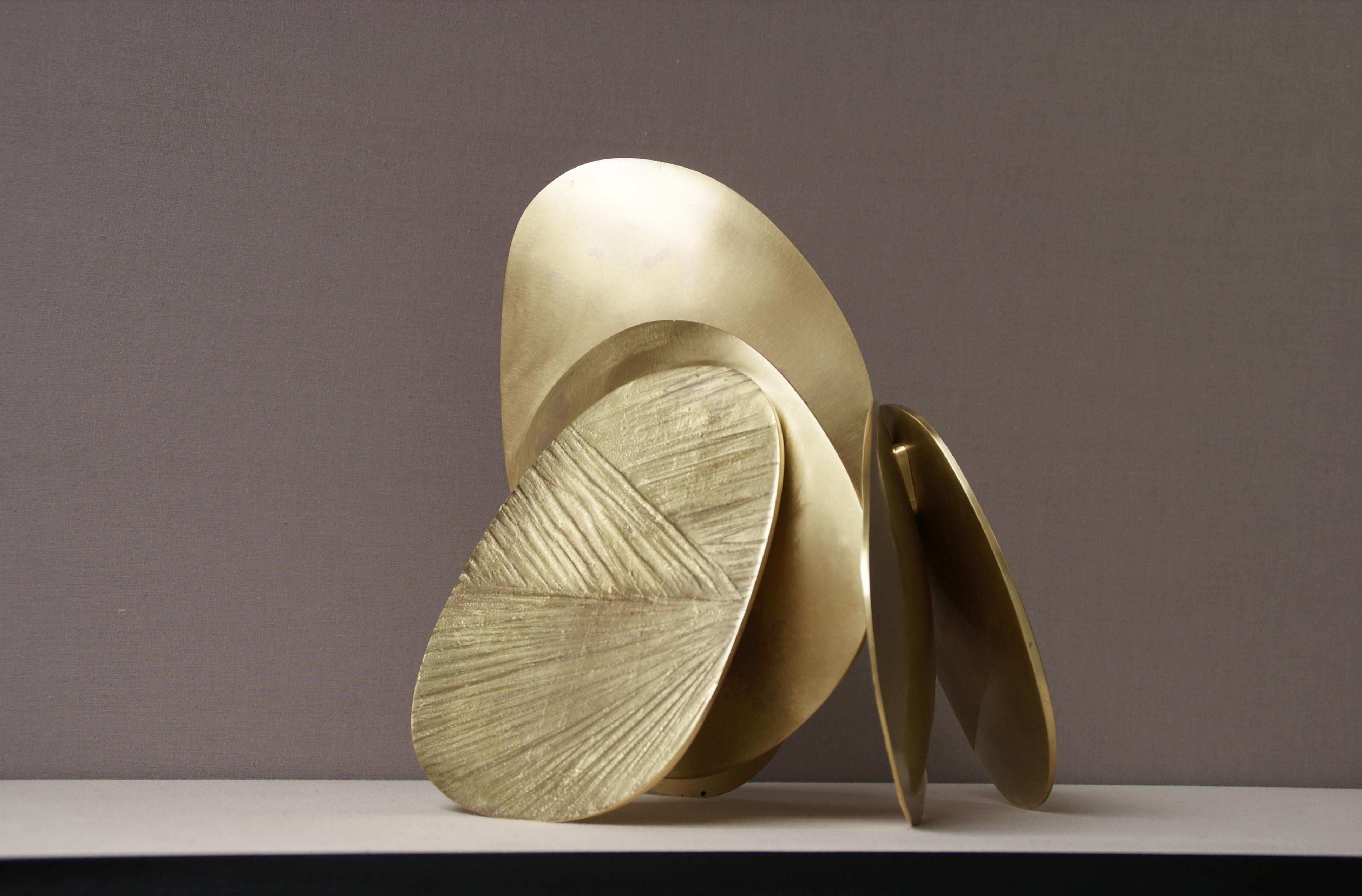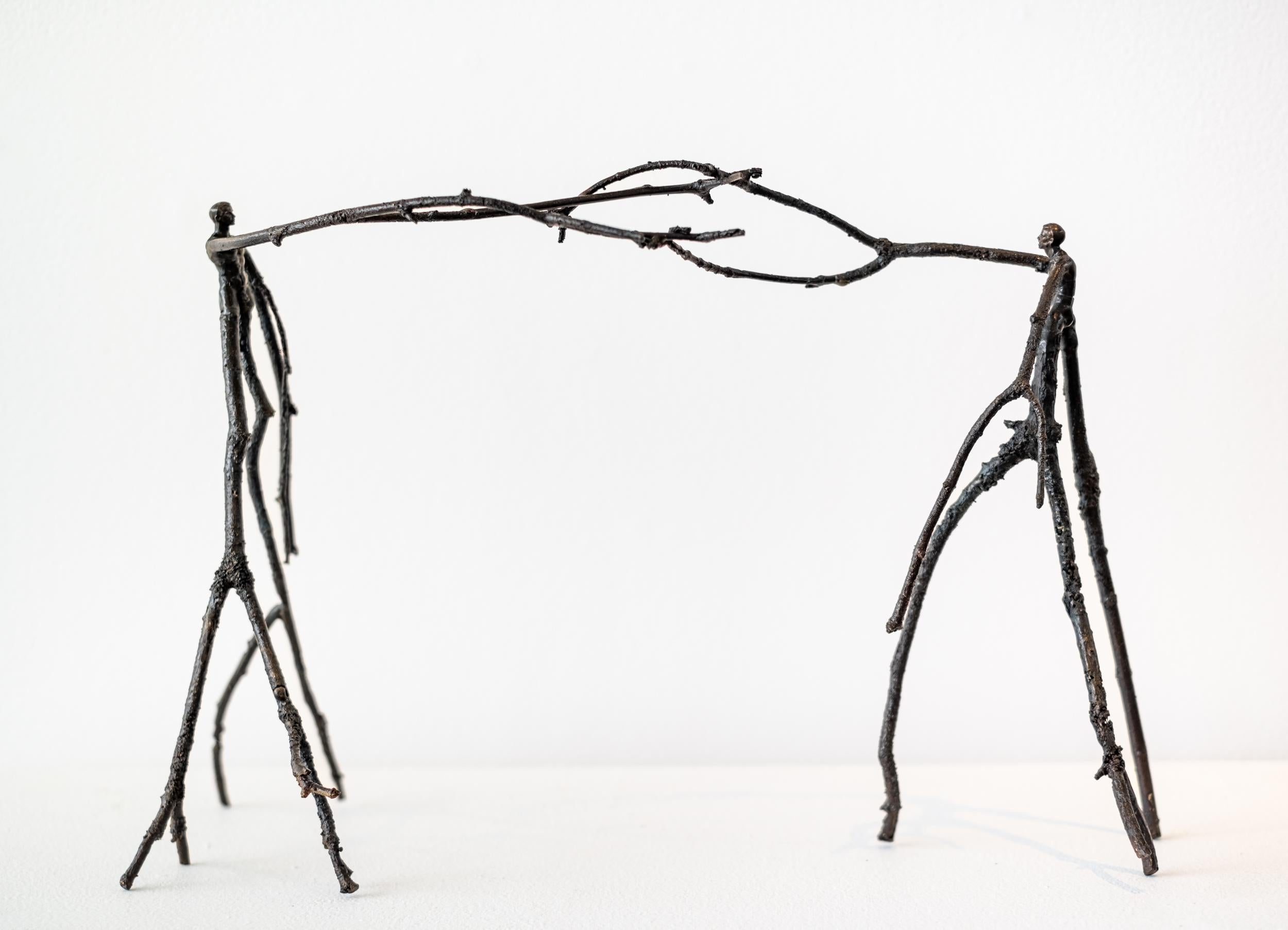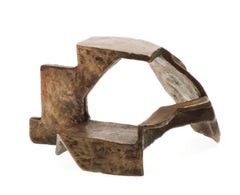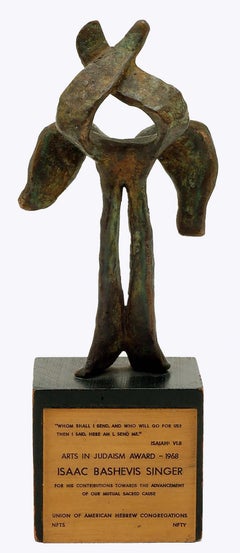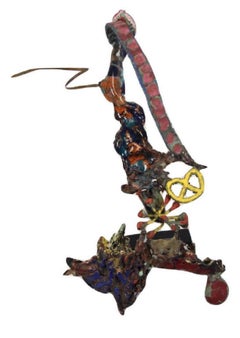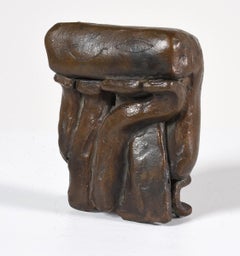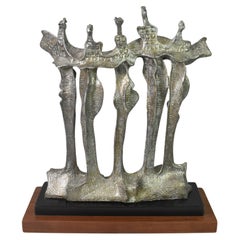Items Similar to The Promise, original signed bronze sculpture by renowned British - US sculptor
Want more images or videos?
Request additional images or videos from the seller
1 of 3
William TuckerThe Promise, original signed bronze sculpture by renowned British - US sculptorca. 1980
ca. 1980
$15,000
£11,320.09
€12,959.79
CA$21,154.97
A$23,225.52
CHF 12,116.80
MX$281,061.15
NOK 151,865.34
SEK 143,097.08
DKK 96,741.36
About the Item
William Tucker
The Promise, ca. 1980
Bronze
Signed and numbered 5/6 - incised on the metal
2 5/8 × 8 5/8 × 1 inch
This abstract sculpture is by the renowned modern British born sculptor, William Tucker. This is a maquette for an important larger public sculpture "The Promise" that was part of the Martin Margulies public collection. William Tucker, along with the renowned sculptor Isaac Witkin and Philip King were part of a group of sculptors called "The New Generation" which shook up the art world in the 1960s.
Very good vintage condition
William Tucker Biography
William Tucker read Modern History at Brasenose College, Oxford from 1955 to 1958, while also attending the Ruskin School of Drawing. In 1957 he was inspired by the exhibition Sculpture 1857-1957 at Holland Park to make his first sculptures. He made his first abstract constructions in steel and wood while studying at the Central School of Art and Design with John Warren Davies, and subsequently with Antony Caro at St Martin’s School of Art in 1959-60.
At St Martin’s he met Phillip King, David Annesley and the other young sculptors, whose work was to make a radical break with tradition: their sculpture was abstract, constructed in modern industrial materials and placed directly on the ground, in contrast to the figurative bronzes on pedestals favoured in the 1950s and earlier. The new sculpture was shown as a group in the influential New Generation exhibition at the Whitechapel Gallery in 1965 and in other exhibitions in the US and Europe in the 1960s.
Tucker had one person exhibitions at various galleries in London and New York from 1963, and represented Britain in the Venice Biennale of 1972 with sculptures that were more linear and optical in character, such as the Cat’s Cradle and Beulah series. He was given the first one person exhibition at the Arts Council Serpentine Gallery in 1973, and in 1975 curated the exhibition The Condition of Sculpture at the Hayward Gallery.
Tucker taught at Goldsmiths’ College and St Martin’s during the 1960s, and in 1969 was appointed Gregory Fellow in Sculpture at the University of Leeds, where he gave a series of lectures on early modern sculpture; these were compiled with other essays and published in 1974 as The Language of Sculpture. His sculpture became larger and more frontal in aspect with such pieces as Tunnel (1975), now in the collection of the Tate Gallery, and Angel commissioned by the Scottish Arts Council for Livingstone New Town in 1976.
Working in Brooklyn, New York, in the late 1970s, Tucker continued to show constructions in steel and wood on an architectural scale, such as An Ellipse (now in the collection of the Guggenheim Museum) and The House of the Hanged Man (the Museum of Modern Art, New York). Permanent installations of work from that period include The Rim in Atlanta, Georgia, and Victory, commissioned in 1998 for the Parque de la Memoria, Buenos Aires, Argentina.
In the early 1980s Tucker moved his studio to upstate New York, and started to work directly in plaster on a scale directly related to the human figure. Cast in bronze, these sculptures were shown with earlier steel and wood constructions in William Tucker, the American Decade at the Storm King Art Center in 1987. Okeanos in that exhibition was commissioned for the Scripps Clinic and Research Center, La Jolla, California. Tucker has continued to work in plaster for bronze up to the present day at a variety of scales, and with progressively more reference to the human body, both in image and handling of the material.
During the 1990s he made many large charcoal drawings and a series of massive sculptures suggestive of male or female torsos, such as Frenhofer at the Goodwood Sculpture Park, and Maia, commissioned for the riverside park in Bilbao, Spain. In 1998 he started a series of roughly modelled heads, which were included in his 2001 retrospective exhibition at the Yorkshire Sculpture Park; he has enlarged several to heroic scale, such as Emperor shown at the RA Summer Exhibition in 2008. Messenger, based on the image of a foot, was recently shown in the Crucible exhibition at Gloucester Cathedral, and over the last several years Tucker has modelled a series of monumental sculptures suggestive of the figure but derived from the image of the hand.
Tucker’s work has been recognized by various awards, including the Sculpture Center (New York) award for Distinction in Sculpture (1991), the Rodin-Moore Memorial Prize, Second Fujisankei Biennale, Japan (1995), the annual award from the New York Studio School (1999), the RA Summer Exhibition Sculpture Prize (2009), and the International Sculpture Center Lifetime Achievement Award (2010).
-Courtesy Royal Academy, London
- Creator:William Tucker (1935)
- Creation Year:ca. 1980
- Dimensions:Height: 2.63 in (6.69 cm)Width: 8.63 in (21.93 cm)Depth: 1 in (2.54 cm)
- Medium:
- Movement & Style:
- Period:
- Condition:Very good vintage condition.
- Gallery Location:New York, NY
- Reference Number:1stDibs: LU1745215929502
About the Seller
5.0
Platinum Seller
Premium sellers with a 4.7+ rating and 24-hour response times
Established in 2007
1stDibs seller since 2022
451 sales on 1stDibs
Typical response time: 2 hours
- ShippingRetrieving quote...Shipping from: New York, NY
- Return Policy
Authenticity Guarantee
In the unlikely event there’s an issue with an item’s authenticity, contact us within 1 year for a full refund. DetailsMoney-Back Guarantee
If your item is not as described, is damaged in transit, or does not arrive, contact us within 7 days for a full refund. Details24-Hour Cancellation
You have a 24-hour grace period in which to reconsider your purchase, with no questions asked.Vetted Professional Sellers
Our world-class sellers must adhere to strict standards for service and quality, maintaining the integrity of our listings.Price-Match Guarantee
If you find that a seller listed the same item for a lower price elsewhere, we’ll match it.Trusted Global Delivery
Our best-in-class carrier network provides specialized shipping options worldwide, including custom delivery.More From This Seller
View AllAbstract Bronze Sculpture, Unique Signed work from the estate of Arthur Carr
By Peter Reginato
Located in New York, NY
Peter Reginato
Abstract Bronze Sculpture, ca. 1987
Bronze
Signed on the underside
4 × 6 1/2 × 5 1/2 inches
This bronze sculpture is by the American abstract sculptor Peter Reginato. ...
Category
1980s Abstract Abstract Sculptures
Materials
Bronze
Untitled signed sculpture, from the collection of Dick Polich, Tallix Foundry
By Stephen Talasnik
Located in New York, NY
Stephen Talasnik
Untitled sculpture, from the collection of Dick Polich, Tallix Foundry, ca. 1997
Cast light metal
signed by the artist on the work (see close up photograph)
6 3/5 × 12 × 4 inches
Provenance
Estate of Dick Polich, founder of the legendary Tallix Foundry and Polich Art works Beacon, NY
Manufacturer
Stephen Talasnik at Tallix Foundry, Beacon, New York
This work is signed by the artist (see close up photograh)
Abstract metal sculpture
The work is lightweight so it is believed to be in aluminum or an aluminum alloy,
Provenance: acquired from the Estate of Dick Polich - founder of the legendary Tallix foundry and Polich Art Works.
Polich and Tallix fabricated significant sculptural works over many years, collaborating with such as, Willem de Kooning, Jeff Koons, Roy Lichtenstein, Frank Stella, Helen Frankenthaler, ERTE, Julian Schnabel, Richard Artschwager, Isamu Noguchi, Isaac Witkin...
Category
1990s Abstract Expressionist Abstract Sculptures
Materials
Metal
Bronze Sculpture to Isaac Bashevis Singer, Arts in Judaism Award signed Judaica
By Nathaniel Kaz
Located in New York, NY
Nathaniel Kaz
Bronze Sculpture to Isaac Bashevis Singer for Arts in Judaism Award, 1966
Bronze, Square wooden base, Metal tag
Signed and dated "66" to back of bronze portion of the w...
Category
1960s Abstract Expressionist Abstract Sculptures
Materials
Metal, Bronze
Famed sculptor Nancy Graves unique signed patinated bronze sculpture NY Award
By Nancy Graves
Located in New York, NY
Nancy Graves
New York State Governor's Arts Award, 1988
Bronze, polychrome patina and baked enamel on base with Award plaque
10 1/4 × 7 × 10 1/4 inches
Hand signed and dated with inc...
Category
1980s Abstract Expressionist Abstract Sculptures
Materials
Enamel, Bronze
Uxmal, unique bronze sculpture by Greek-American sculptor and Harvard professor
Located in New York, NY
Dimitri Hadzi
Uxmal, 1991
Cast bronze on custom made granite base
17 × 30 1/2 × 14 inches
The title UXMAL, refers to the ancient Mayan city of Uxmal, which is known for its "Pyramid of the Magician"
Provenance:
Acquired by the original owner from the prestigious Gremillion Gallery in Houston, Texas (accompanied by a copy of the original receipt)
Measurements:
Base:
26.5 by 11 by 1.75 inches
Work longest
30.5 inches
Widest 14 inches
Highest. 17 inches
More about Dimitri Hadzi"
Derived from the figure and mythic narratives, Hadzi’s sculpture references antiquity and classical artifacts – abstracted anatomical forms, columnar and other architectural elements, helmets, weaponry and body armor function as visual metaphors for ancient cultures. “I was interested in mythology, and I was interested in movement,” Hadzi remarked on his years in Rome, “I was attempting through formal methods to exaggerate sexual tension or apprehension. Suddenly I was myself in an atmosphere of freedom.” [1] Powerfully rendered in bronze his sculptures convey raw emotion, brute strength and mass, tempered with a delicate rush of whimsy, vivacity and sensuality.
Born in New York City on March 21, 1921, Hadzi graduated from Cooper Union in 1950 and received a Fulbright Fellowship in the same year. After studying sculpture in Greece, he moved to Rome under the GI Bill where he lived for twenty-five years. Hadzi returned to the U.S. where he taught at Harvard University for fourteen years. He continued to create sculpture until his death in 2006.
Hadzi is included in the permanent collections of the Museum of Modern Art; the Whitney Museum of American Art; the Museum of Fine Arts, Boston; the Hirshhorn Museum and Sculpture Garden; The Phillips Collection and the Guggenheim Museum. Receiving over twenty sculpture commissions, Hadzi’s work appears in public squares, concert halls, federal and private plazas, and universities throughout the world.
---------------
[1] Elsen, Albert. “On Artistic Freedom: An Interview,” Dimitri Hadzi, (New York: Hudson Hills Press, 1996), 30.
Additional Biography:
Dimitri Hadzi (1921 – 2006) is among the most distinguished modernist sculptors, creator of works in bronze and stone that are powerfully abstract and expressionist in character. His contribution to the international language of sculpture continues to influence and inspire through permanent installations and collections, and exhibitions worldwide.
Born to Greek-American immigrant parents in New York City, he had a talent for drawing at an early age and won a prize for his young ability. But, it wasn't until after serving in the Air-force in the South Pacific during WWII that he turned his sights fully to painting and sculpture, going on to study both at Cooper Union. Eventually, he would become a mainstay of the Cambridge, MA art community. He was a Guggenheim Fellow (1957), the winner of the Venice Biennale Award (1962), and the Rome Prize (1974).
His most notable sculptures are: Copley Place Waterfall (Boston, MA), Owen Glass Co. (Toledo, OH), as well as Thermopolis, adjacent to Boston’s City Hall Plaza, and the former Omphalos in Harvard Square (Cambridge, MA).
Hadzi is included in the permanent collections of the Museum of Modern Art; National Gallery of Art; Whitney Museum of American Art; Museum of Fine Art, Boston; Hirshhorn Museum and Sculpture Garden; The Phillips Collection and the Guggenheim Museum.
Additionally, Hadzi was also a prolific painter, and printmaker. He also taught at Harvard University for over a decade. Famously, David Hockney attended one of Hadzi’s classes at the Carpenter Center at Harvard, where Hadzi served as director. The two of them spent time together painting and discussing techniques. Hockney gifted Hadzi one of his paintings.
He worked alongside his good friend, Nobel Prize winning Irish poet...
Category
1990s Abstract Abstract Sculptures
Materials
Granite, Bronze
Maquette for Laureate (unique sculpture)
By Seymour Lipton
Located in New York, NY
Seymour Lipton
Maquette for Laureate, ca. 1968-1969
Nickel silver on monel metal
Unique
18 × 8 1/2 × 7 inches
Marlborough-Gerson Gallery, New York
Acquired from the above by the previous owner, 1969
thence by descent
Christie's New York: Monday, June 30, 2008 [Lot 00199]
Acquired from the above Christie's sale This unique sculpture by important Abstract Expressionist sculptor Seymour Lipton is a maquette of the monumental sculpture "Laureate" - one of Lipton's most iconic and influential works located on the Riverwalk in downtown Milwaukee, Wisconsin. Laureate is a masterpiece that was commissioned by the Allen-Bradley Company in memory of Harry Lynde Bradley and as an enhancement for the newly constructed Performing Arts Center. It is located on the east bank of the Milwaukee River at 929 North Water Street. The Bradley family in Milwaukee were renowned patrons of modernist sculpture, known for their excellent taste who also founded an eponymous sculpture park. For reference only is an image of the monumental "Laureate" one of Milwaukee's most beloved public sculptures. According to the Smithsonian, which owns a different unique variation of this work, "The full-size sculpture Laureate was commissioned by the Marcus Center for the Performing Arts in Milwaukee. In the initial drawings, Seymour Lipton combined details from the architectural plan with a wide variety of images, ranging from musical instruments to a lighthouse on the island of Tobago. He transformed the basic shapes from these sketches into a welded sculpture, which evokes a figure composed of columns, harp strings, and coiled rope. Lipton created this piece to celebrate achievement in the arts. The dramatic silhouette commands your attention, reflecting the title Laureate, which means worthy of honor and distinction. The final version of the piece is over twelve feet high and stands out against the pale, flat buildings of the arts center.,,"
Provenance
Marlborough-Gerson Gallery, New York
Acquired from the above by the previous owner, 1969
thence by descent
Christie's New York: Monday, June 30, 2008 [Lot 00199]
Acquired from the above Christie's sale
About Seymour Lipton:
Born in New York City in 1903, Seymour Lipton (1903-1986) grew up in a Bronx tenement at a time when much of the borough was still farmland. These rural surroundings enabled Lipton to explore the botanical and animal forms that would later become sources for his work. Lipton’s interest in the dialogue between artistic creation and natural phenomena was nurtured by a supportive family and cultivated through numerous visits to New York’s Museum of Natural History as well as its many botanical gardens and its zoos. In the early 1920s, with the encouragement of his family, Lipton studied electrical engineering at Brooklyn Polytechnic Institute and pursued a liberal arts education at City College. Ultimately, like fellow sculptor Herbert Ferber, Lipton became a dentist, receiving his degree from Columbia University in 1927. In the late 1920s, he began to explore sculpture, creating clay portraits of family members and friends.
In addition to providing him with financial security, dentistry gave Lipton a foundation in working with metal, a material he would later use in his artwork. In the early 1930s, though, Lipton’s primary sculptural medium was wood. Lipton led a comfortable life, but he was also aware of the economic and psychological devastation the Depression had caused New York. In response, he generally worked using direct carving techniques—a form of sculpting where the artist “finds” the sculpture within the wood in the process of carving it and without the use of models and maquettes. The immediacy of this practice enabled Lipton to create a rich, emotional and visual language with which to articulate the desperation of the downtrodden and the unwavering strength of the disenfranchised. In 1935, he exhibited one such early sculpture at the John Reed Club Gallery in New York, and three years later, ACA Gallery mounted Lipton’s first solo show, which featured these social-realist-inspired wooden works. In 1940, this largely self-taught artist began teaching sculpture at the New School for Social Research, a position he held until 1965.
In the 1940s, Lipton began to devote an increasing amount of time to his art, deviating from wood and working with brass, lead, and bronze. Choosing these metals for their visual simplicity, which he believed exemplified the universal heroism of the “everyman,” Lipton could also now explore various forms of abstraction. Lipton’s turn towards increasing abstraction in the 1940s allowed him to fully develop his metaphorical style, which in turn gave him a stronger lexicon for representing the horrors of World War II and questioning the ambiguities of human experience. He began his metal work with cast bronze sculptures, but, in 1946, he started welding sheet metal and lead. Lipton preferred welding because, as direct carving did with wood, this approach allowed “a more direct contact with the metal.”[ii] From this, Lipton developed the technique he would use for the remainder of his career: “He cut sheet metal, manipulated it to the desired shapes, then joined, soldered, or welded the pieces together. Next, he brazed a metal coating to the outside to produce a uniform texture.”[iii]
In 1950, Lipton arrived at his mature style of brazing on Monel metal. He also began to draw extensively, exploring the automatism that abstract expressionist painters were boasting at the time. Like contemporaries such as Jackson Pollock, Lipton was strongly influenced by Carl Jung’s work on the unconscious mind and the regenerative forces of nature. He translated these two-dimensional drawings into three-dimensional maquettes that enabled him to revise his ideas before creating the final sculpture.The forms that Lipton produced during this period were often zoomorphic, exemplifying the tension between the souls of nature and the automatism of the machine.
In the years following the 1950s, Lipton’s optimism began to rise, and the size of his work grew in proportion. The oxyacetylene torch—invented during the Second World War—allowed him to rework the surfaces of metal sculptures, thus eliminating some of the risks involved with producing large-scale finished works. In 1958, Lipton was awarded a solo exhibition at the Venice Biennale and was thus internationally recognized as part of a small group of highly regarded avant-garde constructivist sculptors. In 1960, he received a prestigious Guggenheim Award, which was followed by several prominent public commissions, including his heroic Archangel, currently residing in Lincoln Center’s David Geffen Hall.
A number of important solo exhibitions of his work followed at The Phillips Collection in Washington, DC (1964); the Milwaukee Art Center and University of Wisconsin, Milwaukee (1969); the Virginia Museum of Fine Arts in Richmond (1972); the Everson Museum in Syracuse, NY (1973); the Herbert E. Johnson Museum of Art of Cornell University in Ithaca, NY (1973); the National Collection of Fine Arts, Smithsonian Institution (now the Smithsonian American Art Museum) in Washington, DC (1978); and a retrospective in 1979 at The Jewish Museum in New York. In 1982 and 1984 alone, two exhibitions of his sculpture, organized respectively by the Mint Museum (Charlotte, NC) and the Hillwood Art Gallery of Long Island University (Greenvale, NY), traveled extensively across museums and university galleries around the nation. In 2000, the traveling exhibition An American Sculptor: Seymour Lipton was first presented by the Palmer Museum of Art of Pennsylvania State University in University Park. Most recently, in 2009, the Ackland Art Museum in Chapel Hill, NC mounted The Guardian and the Avant-Garde: Seymour Lipton’s Sentinel II in Context.
Since 2004, Michael Rosenfeld Gallery has been the exclusive representative of the Estate of Seymour Lipton and has presented two solo exhibitions of his work—Seymour Lipton: Abstract Expressionist Sculptor (2005) and Seymour Lipton: Metal (2008). In 2013, Michael Rosenfeld Gallery presented Abstract Expressionism, In Context: Seymour Lipton, which included twelve major sculptures by the artist, along with works by Charles Alston, Norman Bluhm, Beauford Delaney, Willem de Kooning, Jay DeFeo, Michael Goldberg, Adolph Gottlieb, Hans Hofmann, Lee Krasner, Norman Lewis, Conrad Marca-Relli, Boris Margo, Alfonso Ossorio, Richard Pousette-Dart, Milton Resnick, Charles Seliger...
Category
1960s Abstract Expressionist Abstract Sculptures
Materials
Metal, Silver
You May Also Like
Eugene Caples "Bronze Sculpture II" Abstract Bronze Sculpture
By Eugene Caples
Located in Detroit, MI
This small exquisite "Bronze Sculpture II" is in excellent condition and a perfect example of Eugene Caples craftsmanship. This is mainly abstract with some graphic or architectural elements and is so delightful that mythical creatures demand to be considered. It cries out to be touched and held, looked at and caressed. The beautiful patina on the surface gives voice to the many hands that have done these things.
Eugene Caples is a designer and craftsman who worked in Kansas City in the 1960s and later through the early 21st century. He attended the Kansas City Art Institute, earning his Bachelors of Fine Arts in Industrial Design in 1959. In 1963 he was accepted to Cranbrook Academy of Art, Bloomfield Hills, Michigan. The Cranbrook Academy of Art was designed by architect and faculty member, Eliel Saarinen who collaborated with Charles and Ray Eames on chair and furniture design. Numerous creative artists are alumni of Cranbrook and include: Harry Bertoia, Florence Knoll, Jack Lenor Larsen, Donald...
Category
Late 20th Century American Modern Abstract Sculptures
Materials
Bronze
Eugene Caples "Bronze Sculpture I" Abstract Bronze Sculpture
By Eugene Caples
Located in Detroit, MI
This small exquisite "Bronze Sculpture I" is in excellent condition and a perfect example of Eugene Caples craftsmanship. Although it is mainly abstract, there are bits that look figurative either an arm or a leg attempting to emerge from a fold or attempting to hold a pose such as in yoga. It cries out to be touched and held, looked at and caressed. The beautiful patina on the surface gives voice to the many hands that have done these things.
Eugene Caples is a designer and craftsman who worked in Kansas City in the 1960s and later through the early 21st century. He attended the Kansas City Art Institute, earning his Bachelors of Fine Arts in Industrial Design in 1959. In 1963 he was accepted to Cranbrook Academy of Art, Bloomfield Hills, Michigan. The Cranbrook Academy of Art was designed by architect and faculty member, Eliel Saarinen who collaborated with Charles and Ray Eames on chair and furniture design. Numerous creative artists are alumni of Cranbrook and include: Harry Bertoia, Florence Knoll, Jack Lenor Larsen, Donald Lipski, Duane Hanson, Nick Cave, Hani Rashid, George Nelson, Urban Jupena (Nationally recognized fiber artist), Artis Lane (the first African-American artist to have her sculpture, "Sojourner Truth," commissioned for the Emancipation Hall in the Capital Visitor Center in Washington DC), Cory Puhlman (televised Pastry Chef extraordinaire), Thom O’Connor (Lithographs), and Paul Evans (Created Brutalist-inspired sculpted metal furnishings.)
Gene worked...
Category
Late 20th Century American Modern Abstract Sculptures
Materials
Bronze
Carole Harrison Cast Bronze Abstract Sculpture
Located in Toledo, OH
This beautiful abstract cast bronze sculpture is by Carole Harrison. This piece is 11 1/2"h x 10"w x 3 3/4"d and is not signed. Carole Harrison (10/30/33 - 4/4/22) - Born in Illinois...
Category
Late 20th Century American Modern Abstract Sculptures
Materials
Bronze
Samuel Latour - Éclat - Original Bronze Sculpture
By Samuel Latour
Located in Collonge Bellerive, Geneve, CH
Samuel Latour - Éclat - Original Bronze Sculpture
28 x 24 x 27 cm
Edition of 8
Signed
Samuel LATOUR
Formed at Boulle arts and craft school in Paris, h...
Category
2010s Modern Abstract Sculptures
Materials
Bronze
Greeting - surrealist, abstract, figurative, male, bronze sculpture
By P. Roch Smith
Located in Bloomfield, ON
This indoor figurative bronze sculpture is made by Canadian artist Roch Smith.
The imaginative sculptural work of Roch Smith often takes a playful approach to more serious themes. H...
Category
2010s Contemporary Figurative Sculptures
Materials
Bronze
Mounted Abstract Bronze Sculpture
By Harry Bertoia, Albert Paley
Located in Los Angeles, CA
Bronze abstract sculpture on a wood plinth base by Palewic, 1981. The sculpture features a "rock" center surrounded by drips of bronze one of which mounts the sculpture to the base. ...
Category
Vintage 1980s American Post-Modern Mounted Objects
Materials
Bronze
